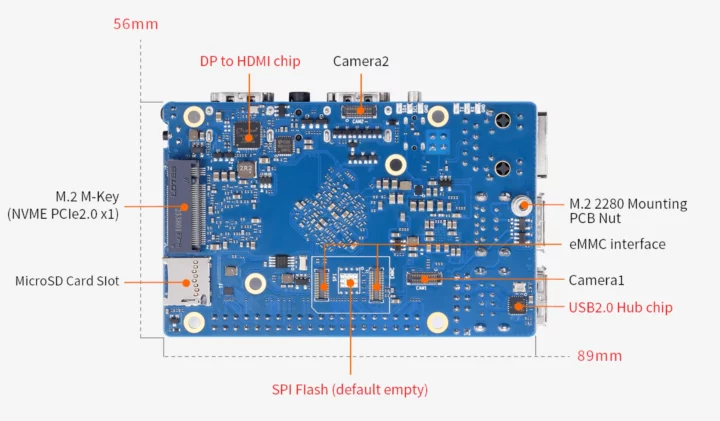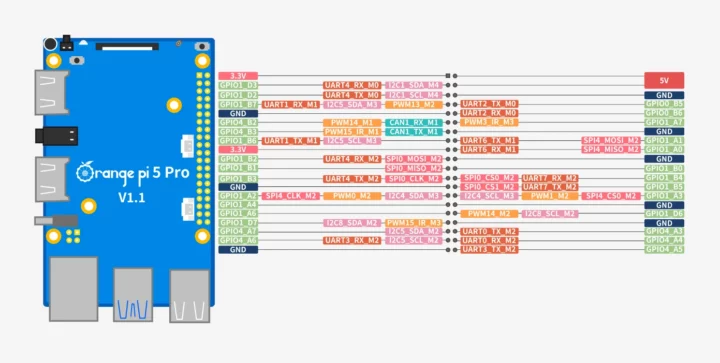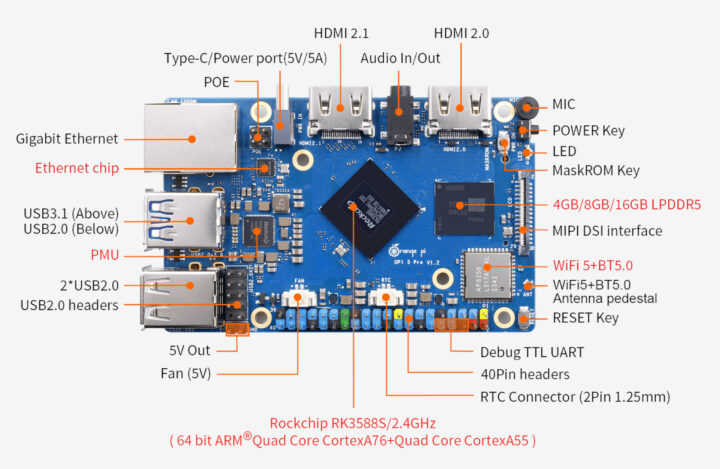As mentioned in the Orange Pi Developer Conference 2024 article, the Orange Pi 5 Pro launch was just around the corner, and the latest Rockchip RK3588S SBC is now available on Amazon or Aliexpressfor $109 and up with 16GB LPDDR5 RAM, but cheaper 4GB ($60) and 8GB ($80) variants are coming soon.
One would think the Orange Pi 5 Pro would be an evolution of the Orange Pi 5 SBC with LPDDR4 memory, and in some ways it is, but there are enough changes to display ports, storage, wireless, GPIO header, and even the form factor that make a direct comparison challenging.
Orange Pi 5 Pro specifications:
- SoC – Rockchip RK3588S
- CPU – Octa-core processor with 4x Cortex-A76 cores @ up to 2.4 GHz, 4x Cortex-A55 cores @ up to 1.8 GHz
- GPU – Arm Mali-G610 MP4 GPU with OpenGL ES 3.2, OpenCL 2.2, and Vulkan 1.2 support
- VPU – 8Kp60 video decoder for H.265/AVS2/VP9/H.264/AV1 codecs, 8Kp30 H.265/H.264 video encoder
- AI accelerator – 6 TOPS NPU
- System Memory – 4GB, 8GB, 16GB LPDDR5
- Storage
- eMMC socket
- SPI NOR Flash footprint
- M.2 2280 M-Key socket for NVMe (PCIe 2.0 x1) or SATA SSD
- MicroSD card slot
- Video Output
- HDMI 2.1 up to 8Kp60
- HDMI 2.0 up to 4Kp60 using a DisplayPort to HDMI bridge
- 4-lane MIPI DSI connector up to 4Kp60
- Camera I/F – 2x 4-lane MIPI CSI connectors
- Audio
- ES8388 audio codec
- 3.5mm audio jack with headphone and microphone support
- Onboard MIC
- Support for HDMI 2.1 eARC
- Networking
- Gigabit Ethernet RJ45 port with optional PoE+ support
- Dual-band Wi-Fi 5 and Bluetooth 5.0 with BLE support via Ampak AP6256 module, external antenna
- USB – 1x USB 3.0 port, 3x USB 2.0 ports (two behind a USB hub chip), 2x USB 2.0 via header
- Expansion
- 40-pin header with up to 28x GPIO, 4x UART, 8x PWM, 4x I2C, 1x SPI, 1x CAN Bus, and 5V, 3.3V, and GND power signals
- M.2 2280 M-Key socket (PCIe 2.0 x1)
- Debugging – UART console in 40-pin GPIO header
- Misc
- MaskROM, Reset, and Power buttons
- RGB LED
- 2-pin 5V fan connector
- 2-pin 3V RTC connector
- Power Supply
- 5V/5A via USB Type-C port
- RK806-1 PMU
- Dimensions – 89 x 56 mm
- Weight – 62 grams
 The company says the new board supports Orange Pi OS (Droid), Orange Pi OS (Arch), Ubuntu, Debian, and Android 12 operating systems. You’ll find all those images – based on Linux 5.10 – on the product page, as well as the Armbian build script on GitHub.
The company says the new board supports Orange Pi OS (Droid), Orange Pi OS (Arch), Ubuntu, Debian, and Android 12 operating systems. You’ll find all those images – based on Linux 5.10 – on the product page, as well as the Armbian build script on GitHub.
While we welcome the presence of an M.2 socket for NVMe SSD, the PCIe Gen 2.0 x1 interface will limit the performance to 5 Gbps before taking into account overheads. The random and sequential R/W speeds will still be faster than the eMMC flash, but not fully utilize the performance of most NVMe SSDs as we could confirm in our recent review of MAKERDISK M.2 NVMe SSDs with the Raspberry Pi 5.

As noted in the introduction, there are three variants whose official pricing is as follows:
- $60 with 4GB RAM
- $80 with 8GB RAM
- $109 with 16GB RAM
But right now, only the 16GB RAM, and Orange Pi told CNX Software that customers need to wait if they need cheaper 4GB or 8GB models. That means that right now, you’ll only find the Orange Pi 5 Pro 16GB SBC for purchase on Amazon and Aliexpress as well as accessories such as eMMC flash modules, camera modules, and a 5V/5A power supply.

Jean-Luc started CNX Software in 2010 as a part-time endeavor, before quitting his job as a software engineering manager, and starting to write daily news, and reviews full time later in 2011.
Support CNX Software! Donate via cryptocurrencies, become a Patron on Patreon, or purchase goods on Amazon or Aliexpress





